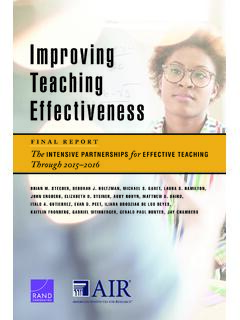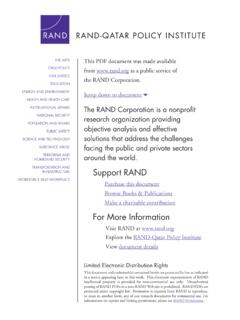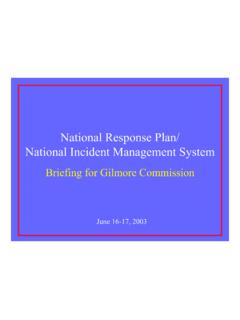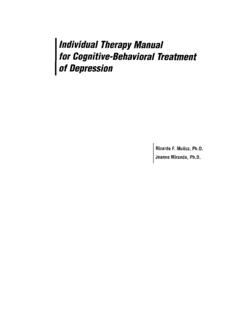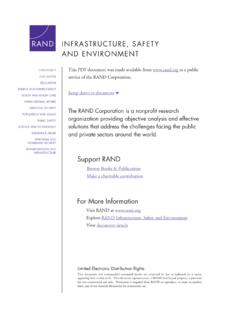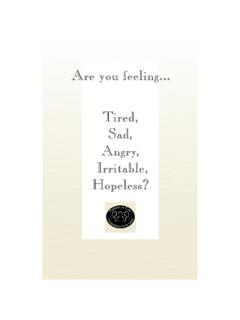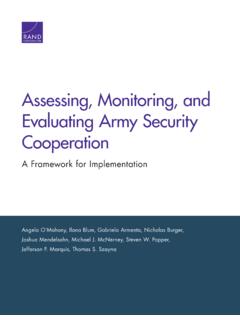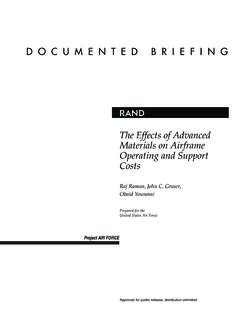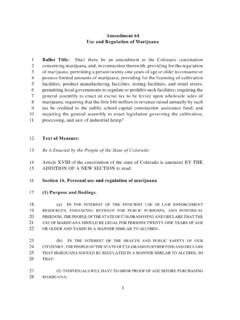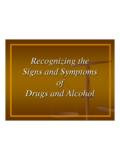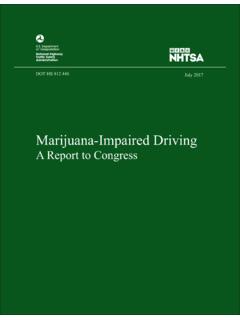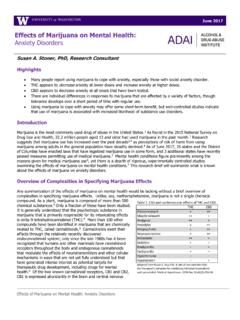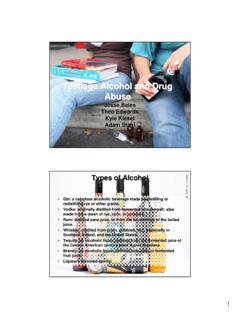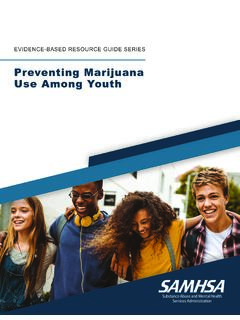Transcription of Marijuana and Crime - RAND Corporation
1 Marijuana and Crime Is There a Connection Beyond Prohibition? ROSALIE LICCARDO PACULA BEAU KILMER WR-125 January 2004 Prepared for the National Institute on Drug Abuse NBER WORKING PAPER SERIESMARIJUANA AND Crime :IS THERE A CONNECTION BEYOND PROHIBITION?Rosalie Liccardo PaculaBeau KilmerWorking Paper 10046 BUREAU OF ECONOMIC RESEARCH1050 Massachusetts AvenueCambridge, MA 02138 October 2003 Research presented in this paper was supported by a grant from the National Institute on Drug Abuse(R01DA12724) to rand . The opinions expressed in this paper are those of the authors and do not reflectthe opinions of the author s institutions or funding agencies. Contact person: Rosalie Liccardo Pacula, rand , 1700 Main St., Box 2138, Santa Monica, CA 90407-2138. Email: The viewsexpressed herein are those of the authors and not necessarily those of the National Bureau of EconomicResearch.
2 2003 by Rosalie Liccardo Pacula and Beau Kilmer. All rights reserved. Short sections of text, not to exceedtwo paragraphs, may be quoted without explicit permission provided that full credit, including notice, isgiven to the source. Marijuana and Crime : Is There a Connection Beyond Prohibition?Rosalie Liccardo Pacula and Beau KilmerNBER Working Paper No. 10046 October 2003 JEL No. K14, K42, I18 ABSTRACTWe examine the relationship between Marijuana use and non-drug related Crime using data on arrestsfrom the Arrestee Drug Abuse Monitoring (ADAM) Program and Uniform Crime Reports. Thereis a positive association between self-reported use at the time of the offence and non-drug relatedviolent, property and income-producing Crime even after accounting for other substance use in theADAM data. Reduced form equations using both data sets only provide evidence supporting a causalmechanism for property and income-producing Crime .
3 In the case of violent Crime , we find astatistically significant association with arrests but not reported Crime , suggesting that Marijuana usemay just influence the likelihood of getting caught committing these Liccardo PaculaRAND1700 Main Box 2138 Santa Monica, CA 90407-2138and KilmerKennedy School of GovernmentHarvard UniversityJohn F. Kennedy StreetCambridge, MA Introduction An extensive literature exists examining the relationship between substance abuse and Crime , the focus of which has typically centered on cocaine, heroin, and alcohol. Few studies specifically examine the relationship between Marijuana and Crime despite consistent findings that Marijuana is the most commonly identified drug among arrestees. Reports from the United States, England, and Australia, for example, all show that approximately 60% of arrestees test positive for Marijuana use and that Marijuana is the drug whose metabolites are most frequently found in arrestees urine (Taylor and Bennett, 1999; Makkai et al.)
4 , 2000). There are two good reasons why inferences should not be made about the relationship between Marijuana and Crime on the basis of urine tests of arrestees. First, very few arrestees who test positive for Marijuana have only used Marijuana . Most of those who test positive for Marijuana also use other illicit drugs or alcohol (NIJ, 2000)1. The use of these other substances may be what motivated the criminal behavior rather than Marijuana . Second, unlike other illegal substances, a positive urine sample for THC only indicates use in the past month; it does not indicate that Marijuana was used immediately prior to the offence taking place. Hence, a positive urine test in the case of Marijuana cannot be interpreted as evidence that the Crime was committed under the influence of Marijuana . Despite its frequent use among arrestee populations, Marijuana has generally been shown to inhibit aggressive behavior and violence in humans and thus it is believed not to be a major contributor to Crime (Miczek et al.
5 , 1994; White and Gorman, 2000). However, in their review of the literature on the topic, the National Research Council concluded that the long-term use of Marijuana may alter the nervous system in ways that do promote violence (National Research 1 Data from the 1999 ADAM sample suggests this figure could exceed 70%. Of the 16,684 arrestees who tested positive for Marijuana , 7,748 ( ) tested also tested positive for another illicit drug and another 4,436 ( ) reported use of alcohol in the previous 72 hours. Council, 1993). Further, a consistent link between frequent cannabis use and violent Crime and property damage has been identified among juveniles (Dembo et al., 1991; Salmelainen, 1995; Baker, 1998). Thus the issue of whether Marijuana use causes Crime , even if limited to a small segment of the population, remains in question.
6 The assumption that drugs and Crime are causally related is a major reason for prohibiting the use of illicit drugs in many developed countries. If Marijuana use is not the cause of Crime , but merely defined as a Crime , then one must consider all the criminal justice resources dedicated to arresting, processing, and adjudicating Marijuana offenders as a cost of prohibition when weighing the cost and benefits of our current Marijuana policy. In this paper, we begin to investigate the causal association between Marijuana use and Crime . Using individual-level data from the Arrestee Drug Abuse Monitoring (ADAM) Program, we examine the relationship between Marijuana use and the probability of getting arrested for a violent, property and income-producing and Crime while controlling for concurrent use of alcohol and cocaine. Models consider the sensitivity of results when Marijuana use is measured by a positive urine test, self-reported use in the past 3 days, and self-reported use at time of the offence.
7 We find that Marijuana use is positively associated with the likelihood of being arrested for a property and income-producing Crime , with reduced form models supporting the conclusion that at least some of the association is causal in nature. This finding is further supported by additional analyses of the number of property and income-producing offence arrests measured in the Uniform Crime Reports (UCR). Models estimating the likelihood of being arrested for a violent Crime using reduced form models are mixed, with no statistical association found in the ADAM sample and a positive association between Marijuana use and violent Crime arrests in the UCR sample. The rest of the paper is organized as follows. In the next section we provide some background on the hypothesized relationship between Marijuana and Crime and the findings to date.
8 In section III we present the theoretical framework. In Section IV, we discuss the empirical model and the primary data sets used to estimate our models. In Section V we present our results and in Section VI we offer some discussion and conclusions. II. Background and Significance Surprisingly few studies have explicitly examined the relationship between cannabis use and Crime . Those studies that have been done generally examine the association within the context of four alternative hypotheses based on Goldstein s (1985) tripartite framework, where the association between Marijuana use and Crime is explained by either psychopharmacological factors, economic-compulsive behavior, systemic violence or common factors. The psychopharmacological model hypothesizes that drug users engage in violent and/or non-violent Crime because of the acute psychoactive effects of the substance (Goldstein, 1985).
9 There is very little support for this model in the case of Marijuana , except for adolescents. Laboratory studies generally show that Marijuana , unlike alcohol, temporarily inhibits aggression and violence (Mizcek et al, 1994; White and Gorman, 2000), raising doubt that any association identified in the data is causal in nature. Still, there is some evidence showing a correlation between chronic Marijuana use and increased risk of violent behavior (White and Hansell, 1998; Kaplan and Damphousse, 1995). Although cannabis use may temporarily inhibit aggression in the general population, it is possible that cannabis use increases aggression in some individuals. In controlled laboratory studies, for example, the relationship between alcohol use and aggression is influenced by subject characteristics, such as gender, aggressive tendencies and cognitive abilities, as well as experimental conditions, such as whether the subject was provoked (Bushman, 1997).
10 Indeed, Bushman s (1990) meta-analysis found more aggression among Marijuana smokers than placebo controls in laboratory experiments, although he notes that the placebo controls showed significantly less aggression than nondrug controls highlighting the importance of individual heterogeneity in general tendencies toward aggression. Nonetheless, it may be the case, as suggested by the US National Research Council (1993), that prolonged use of cannabis promotes violent or aggressive behavior because of changes in the nervous system. There is far more convincing evidence of a link between frequent cannabis use and violent Crime and nonviolent delinquency among juveniles (Salmelainen, 1995; Fergusson and Horwood, 1997; Baker, 1998). In a study of 10,441 secondary students in New South Wales, Australia, students who were frequent cannabis users were two times more likely to participate in assault and malicious damage of property than students who did not use cannabis.
